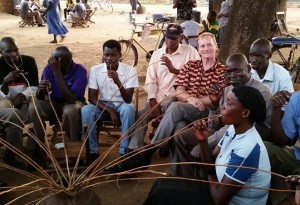Bishop George introduces me as “his brother bishop”; applause, big hug, then I’m in the pulpit. I preach on the Good Shepherd in John 10. How does the Church show forth Jesus as the Good Shepherd?
I tell a story. When I go into the more remote villages, sometimes I will meet small children who have never seen a white person. They know the universal word for the pale variety of human beings– mzungu– but they have never actually seen one. So they will run along the road next to me as I walk laughing and shouting mzungu, mzungu! Sometimes I stop. I walk up to the smallest one, who suddenly gets very sober, and I put out my hand, inviting them to touch me. They usually freak out. “Mam! Mam! (No, No!)” they shout and back away. When I once asked a mom why her little girl did not want to touch me, she replied laughing, “She is afraid that if she touches you she will become white!”
People obviously like the story, totally get it, lots of laughter and broad smiles. I then move to Thomas the apostle, and the Resurrection appearance of Jesus who invites him to put his fingers in the Lord’s wounds and his hand in the Lord’s side. Thomas comes to faith in Christ in that invitation. He can see two things: first he sees that the Lord is not ashamed of His wounds, just as He is not ashamed of ours. He is not ashamed of our suffering or weakness, but literally holds them in His hands. But Thomas also sees the Lord’s glory, His power, His infinite love and eternal joy. He wants to be filled with those things, so He touches the Lord to become like Him.
So, the question is, can we show the world such a Lord, so they can touch Him through us? Can we not be judgmental of others’ sin, condemning them, or moralizing about them, but rather show them the Christ who bears their wounds in His hands? And can we by our joy and love show them His? I was brought to faith by such Christians, and I can see them here, but the abiding temptation of the Church is to act as though we were a place for “good people”, which is like saying a hospital should be full of those who are already well. I trust that, as we follow Him, the Lord will let us touch Him more deeply that we may become like Him, so that others may see Him revealed through our mercy and love, and also be able to touch Him by faith.
People seem encouraged. After communion, I head back to the house, eat briefly, then to the school Pilgrim runs in Soroti, Beacon of Hope College, where Jay and Mark and a few other visitors are already in worship with the community. This is the last Sunday of the term. 500 kids, many of them the poorest of the poor, are gathered with their faculty under the huge fig tree that serves as their church. The morning is rich. They dance, sing, praise God in so many ways. I preach again, a sermon of encouragement, of pride in them and their faith, their accomplishments, a message (I hope) of power for them as they go back to their villages for three weeks (many of them cry as they leave school- especially the girls who find here a dignity and respect that is not accorded to women many places in the countryside).
After lunch, we visit Pilgrim’s health clinic with Dr. Guy who explores the possibility of setting up detox protocols here, then later in the afternoon we go down to Pamba market to visit our old friends in the ajono group– about thirty men and a few women are sitting around a common pot of local brew sipping from long straws. There is a serious card game going on. Jay and I are invited in to kibbitz (i.e. watch, don’t help). The game is a mystery, sort of like Uno, but not quite. We hang around and talk with a few of them. They are always amazed to see a bishop and a priest who want to visit with them, but now a doctor as well? What is going on?
The evening is spent in a wonderful dinner with staff. By the end of the day, I don’t remember if I ever had a problem with my phone. Where is my phone anyway?

